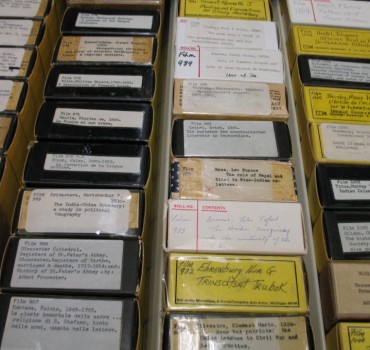This blog is all about showcasing Penn’s collections, these of course include a variety of media and different types of items so I thought I would feature something a bit different this week. Instead of a single item, I want to write about a class of items which, taken as a whole, are certainly “unique” – Penn’s collection of microfilmed manuscripts and archives.

The lowly microfilm has taken a lot of abuse over the years for its sometimes grainy quality, retina-numbing display, and propensity to spool all over the floor when one least expects. However, digging deeply into Penn’s microfilm holdings it’s not hard to see why microtexts have been essential to scholars for decades. Penn’s extended microfilm collections of government documents, obscure magazines, and early printed books all remain valuable even as more and more of them become digitized [1]. Yet for me, it’s the collections of archival material that offer the most continued benefit from the medium.Take the example below from Penn’s microfilm collection – a promissory note for the delivery of beaver pelts in Quebec from 1713. This forms part of a six-reel collection of microfilmed documents relating to French Canada taken from regional archives in France. Instead of making the trip to La Rochelle scholars at Penn have access right now to a wealth of archival material.

Further, as with digital resources, researchers can quickly shift from archive to archive as they change reels. From a source closer to home, below is an image of a 1666 posthumous inventory of the goods of a woman named Charity White, found in the court papers of Suffolk county Massachusetts which are reproduced on 72 rolls of microfilm held at Penn [2].

Among the goods present in the inventory are a “chamber pot,” “a dish or platter,” “a hud and a cloak,””a feather bed,” and various other household items. Containing a record of the material possessions of thousands of people who lived in the Boston area as well as documents relating to bastardy and contested wills these are important sources for scholars of early America and you won’t find them at just any library.
Skipping ahead from the early modern to the modern, Penn holds a wealth of 20th century special collections on microfilm. Doing research on the Cold War and Hollywood? Penn has 14 juicy reels of confidential surveillance files from the entertainment industry. Writing about presidential campaigns and local politics? Try the 51 reels of papers from the archives of the Republican Party. Beyond these large collections look also to the smaller collections which are practically unique to Penn.

The document above, for example, was specially filmed in the 1940s from papers of a Lithuanian exile organization entitled “34 secret documents issued by the People’s Commissariats for Internal Affairs and State Security pertaining to mass arrests, exile, and deportation to corrective labor camps from Lithuania in 1941.” These kinds of documents, held by private organizations and individuals are especially difficult to get a hold of and I suspect that Penn is one of the few places where researchers could find the memos above [3].

Moving again backwards in time, researchers at Penn have access to a treasure trove of medieval manuscripts – many specially microfilmed for Penn faculty. For example, interested in this early-14th century Greek compendium of grammatical and other works?
You have two choices: travel to the Iveron Monastery on Mt. Athos in Greece (sorry no women allowed) or come to Penn and use Van Pelt Microforms Medieval MSS 534 [4]. Want to peruse documents from the Vatican secret Archives? No need to travel to Rome – there are thousands of documents from the archives in the Henry Charles Lea microfilm collection right here at Penn.
Though each microfilm reel at Penn necessarily duplicates a text or item extant elsewhere, taken as a whole, the collection of rare and hard-to-find archival material is truly unique.
——–
[1]
See the excellent guide to large microfilm sets at: <http://gethelp.library.upenn.edu/guides/microforms/microforms.html>. Penn is also a member of the Center for Research Libraries (CRL) which has a lending library of tens of thousands of reels of scarcely held microfilm and well worth checking out.
[2]
These reels cover the years 1629-1799 and are cataloged as Microfilm 689. Only three other libraries hold the complete set.
[3]
These documents were filmed from their owners in New York in the 1940s and it seems that only Penn and the NYPL have copies today.
[4]
For a detailed guide to the majority of the medieval manuscripts on film here at Penn see <http://www.library.upenn.edu/collections/microforms/medmss.html>.

